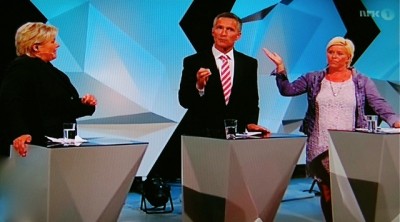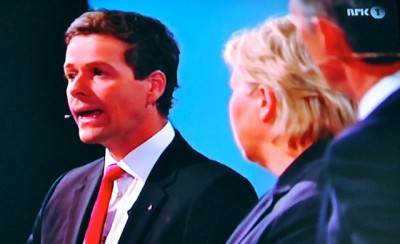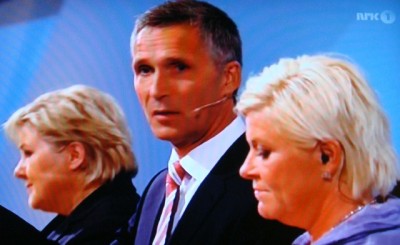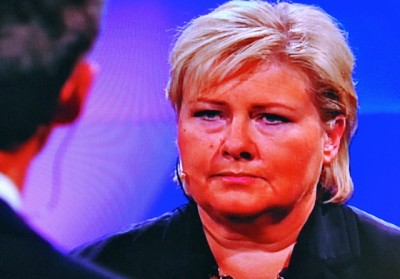NEWS ANALYSIS: Monday night’s first major debate among the leaders of Norway’s seven biggest political parties may have raised more questions than it answered. The biggest among them is what a government formed by the non-socialists would look like, or whether a right-center coalition that truly reflects the will of the voters is even possible.

Then it would need to include Norway’s most conservative party, the Progress Party (Fremskrittsparti, Frp), since it’s Norway’s third-largest party according to recent polls. Judging from comments made during the course of the debate organized and aired by state broadcaster NRK from the coastal city of Arendal, it’s entirely unclear whether that will happen. Doubts are rising over whether the four-party right-center coalition promoted by the Conservatives (Høyre) leader Erna Solberg can come together: The small right-leaning center parties are clearly distancing themselves from Frp, while Frp has been busy distancing itself from the less-conservative Conservatives.
All together, the non-socialists have consistently appeared poised to win away a majority of seats in parliament from the current left-center government coalition led by Stoltenberg’s Labour Party (Arbeiderpartiet, Ap), according to a string of public opinion polls. All the left, right and center parties, though, are campaigning separately ahead of the September 9 election. That’s what’s highlighting the differences among them, instead of letting voters know what their platforms would be if they govern together.

Knut Arild Hareide, leader of the center-oriented Christian Democrats (Kristelig Folkeparti, KrF), went so far as to say Monday night that he thinks a government made up of just Høyre and Frp would be “worse” than today’s left-center government. At the same time, he and other KrF officials are increasingly negative towards the idea of trying to govern with Frp. The differences between them, not least on immigration and welfare issues, are just too great.
Their counterparts at the Liberal party (Venstre) have been saying the same. Venstre leader Trine Skei Grande hammered through her party’s strong environmental policies at Monday night’s debate, not least their stand against oil drilling off Lofoten, and that’s totally at odds with Frp’s and Høyre’s positions. KrF and Venstre see themselves as the “green” element in an otherwise “blue” government, but none of the parties seems willing to campaign on a turquoise platform. KrF’s Hareide said it was the duty of the center parties to “put the brakes” on the more hard-line policies of the bigger parties, hinting that a coalition with just Høyre and Venstre may work.The small parties like his would still need a lot more votes than the polls indicate to have the “muscle” Frp leader Siv Jensen stressed is necessary to have power in a government coalition. Negotiations to form a non-socialist coalition platform, she herself warned, would be “very tough.”

It’s enough to make one wonder whether Solberg of Høyre now has any real chance at all of finding enough common ground among the four non-socialist (borgerlig) parties — Høyre, Frp, Venstre and KrF — to form a government. Not only are doubts rising, some former Venstre ministers told newspaper Dagsavisen on Tuesday that chances for a four-party coalition are now minimal. The other options would be a Høyre coalition with just Frp, a coalition with just Venstre and KrF, or Høyre going it alone, depending on much clout the voters give the individual parties.
Current Prime Minister Jens Stoltenberg seized on that doubt at the debate, challenging Solberg to clarify what voters could really expect from any non-socialist coalition. “We have shown that we can govern,” Stoltenberg claimed, even though he and his partners in the current “red-green” government are also campaigning separately during this election run-up and trailing in the polls. He criticized his “blue-green” rivals’ lack of a common program like Stoltenberg’s “red-green” pact had during the campaigns in 2005 and 2009, suggesting that voters don’t know what they’ll get if they vote for any of the non-socialist parties.

Only a few actual issues were addressed during Monday night’s live debate, including Norway’s controversial annual tax (formueskatt) on net worth (the socialists want to retain it, the non-socialists want to either phase it out or modify it) and the so-called handlingsregel, the rule that limits how much of the country’s oil revenues the government should spend. Prime Minister Jens Stoltenberg’s left-center, Labour-led government has been restrictive, limiting spending to just 4 percent of the size of Norway’s sovereign wealth fund. Solberg of the Conservatives seems inclined to spend more of Norway’s oil revenues “to make our society better, reduce waiting lists for health care, and make schools better.” Her potential government partner, Frp leader Siv Jensen, wants to spend even more, preferring to call it “investing” in projects at home in Norway instead of in the country’s oil fund. The smaller center parties predictably opt for a combination of the two, urging more flexibility in oil revenue use as needed but mostly hanging on to the oil fund’s purse strings.
There are, at least, some key differences between the left-center and right-center alternatives, with NRK’s program leaders joking that Solberg arrived in Arendal in a helicopter while Stoltenberg arrived in a taxi, referring to his taxi campaign stunt late last week. That didn’t stop Frp’s Jensen from accusing the Conservatives of becoming too much like Labour, though, in Tuesday’s Dagens Næringsliv (DN).
It is, perhaps, the ultimate irony that the left-leaning socialists want to restrict government spending in Norway, while the right-leaning non-socialists want to boost spending. That, at any rate, is what help makes Norway an annerledesland, literally a place where things are simply different than elsewhere in the world.
newsinenglish.no/Nina Berglund

